Sir John Monash, Personal Files Book 6, 12 July - 3 August 1915, Part 12
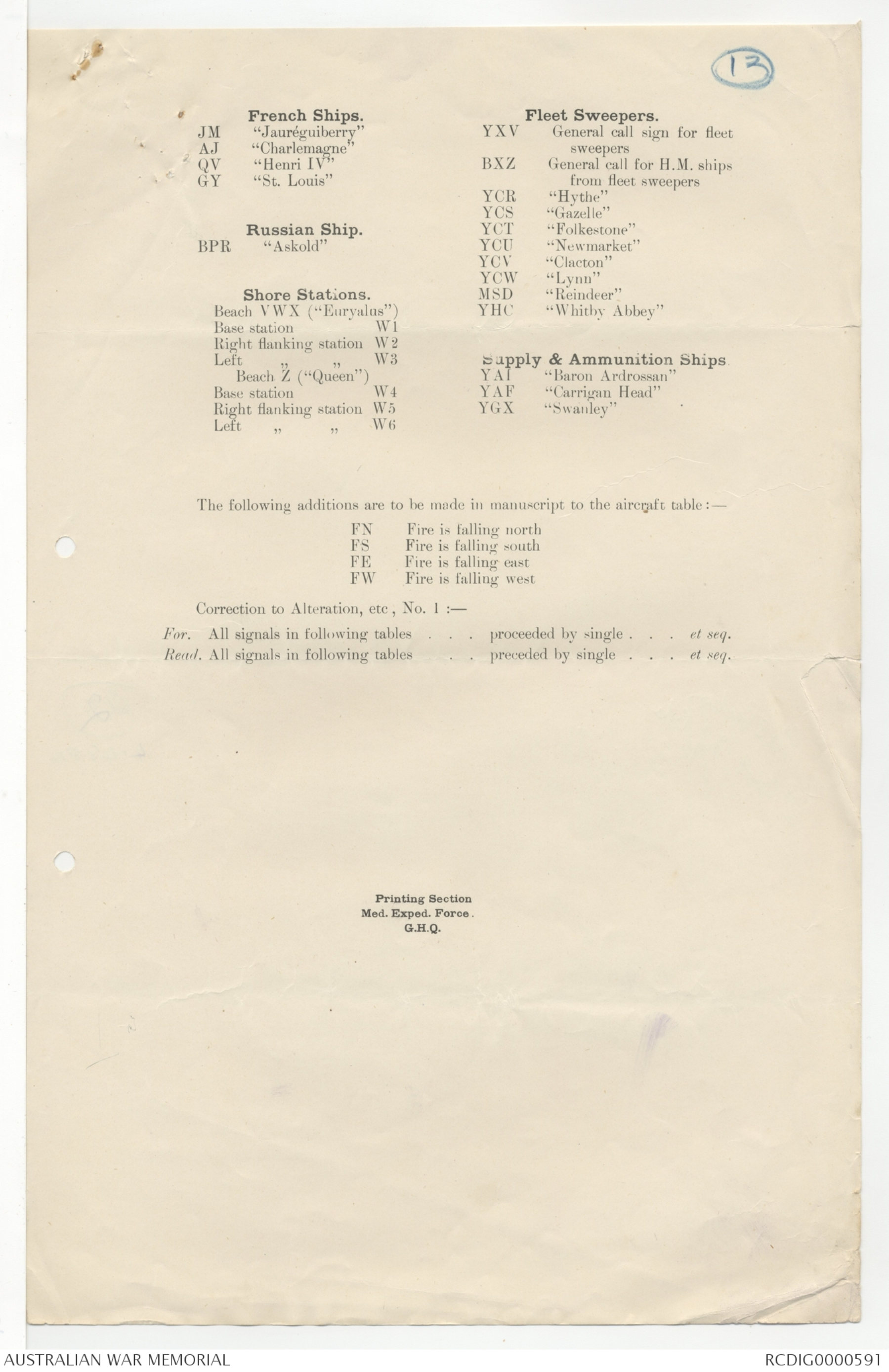
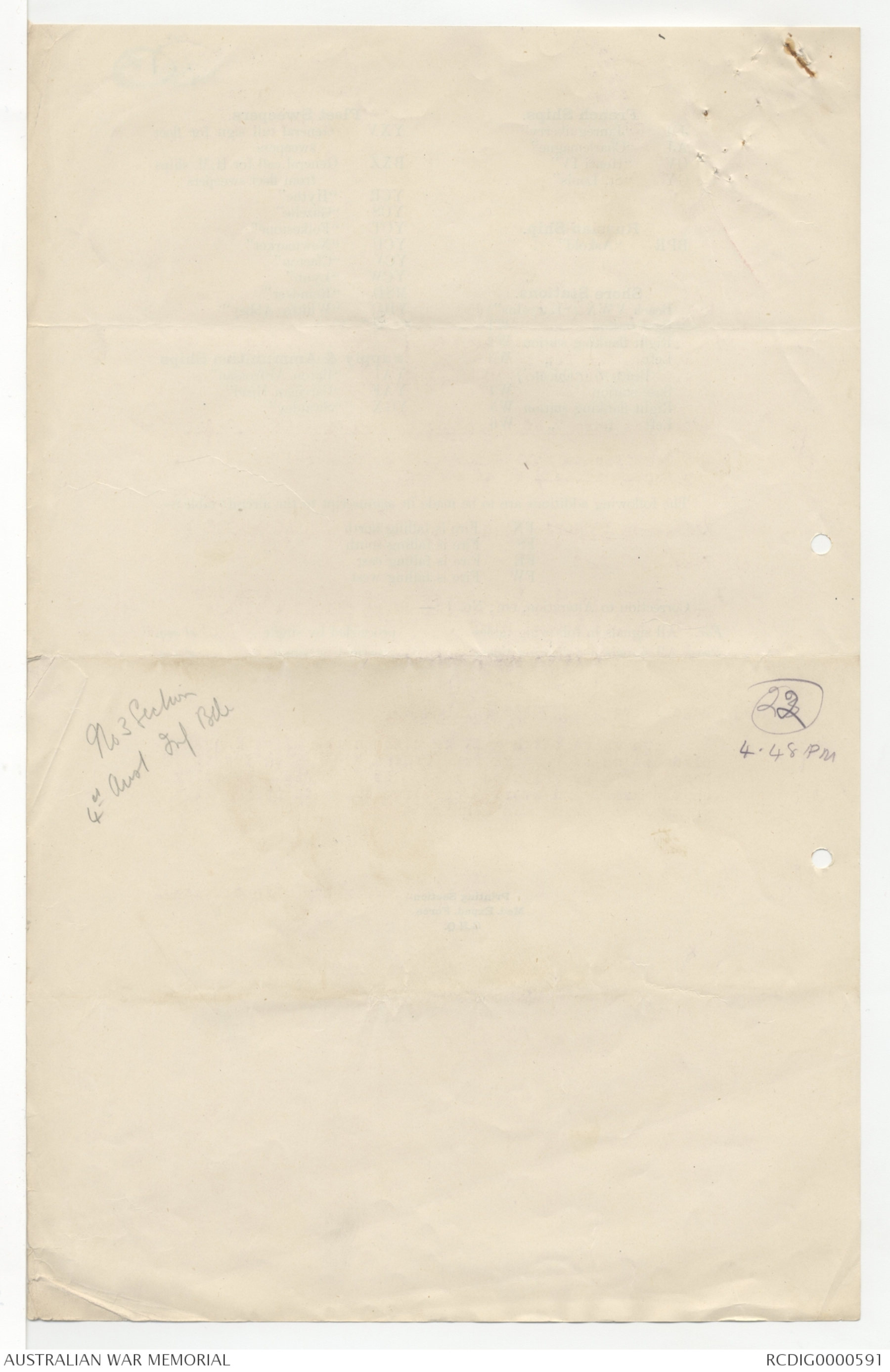
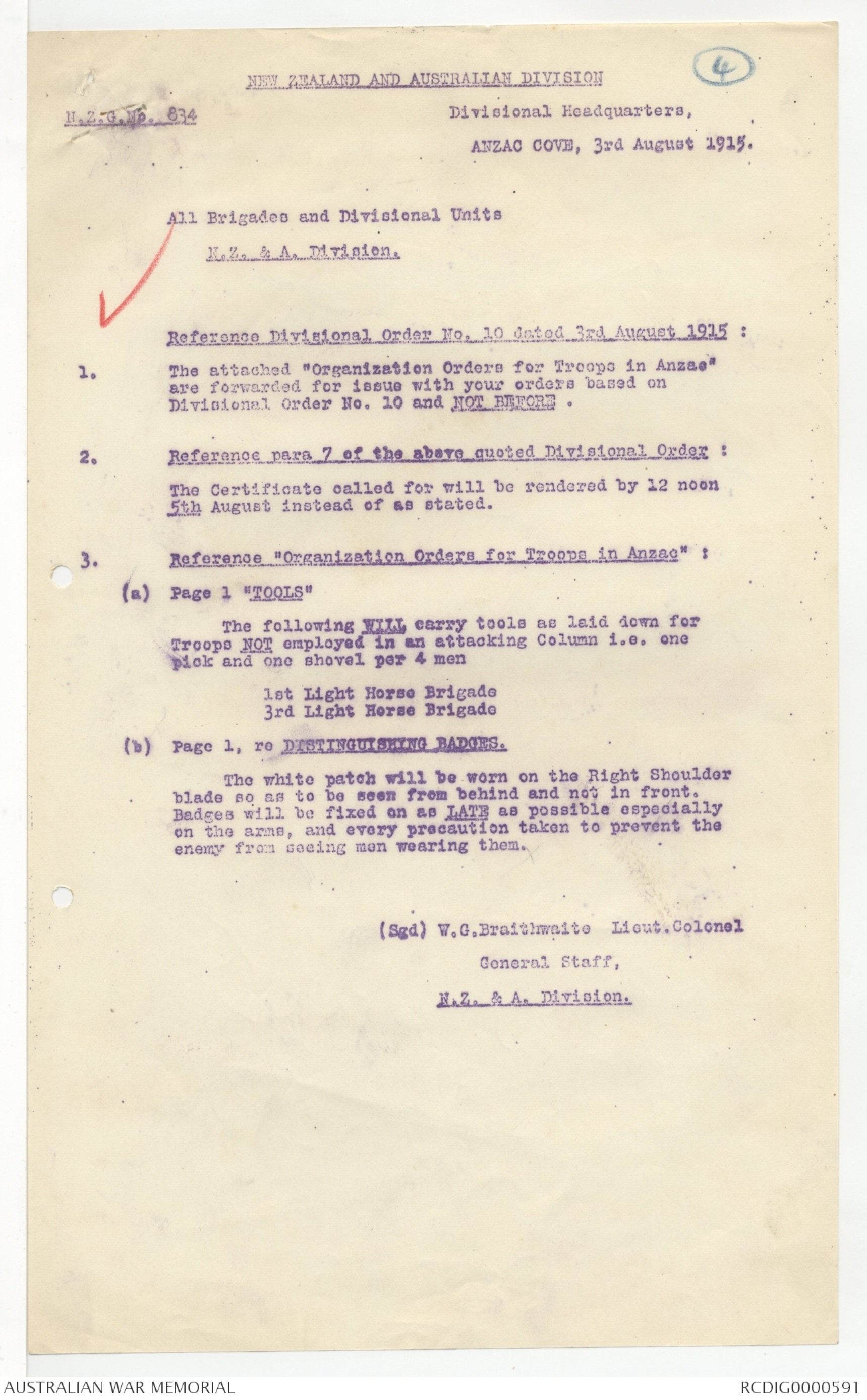
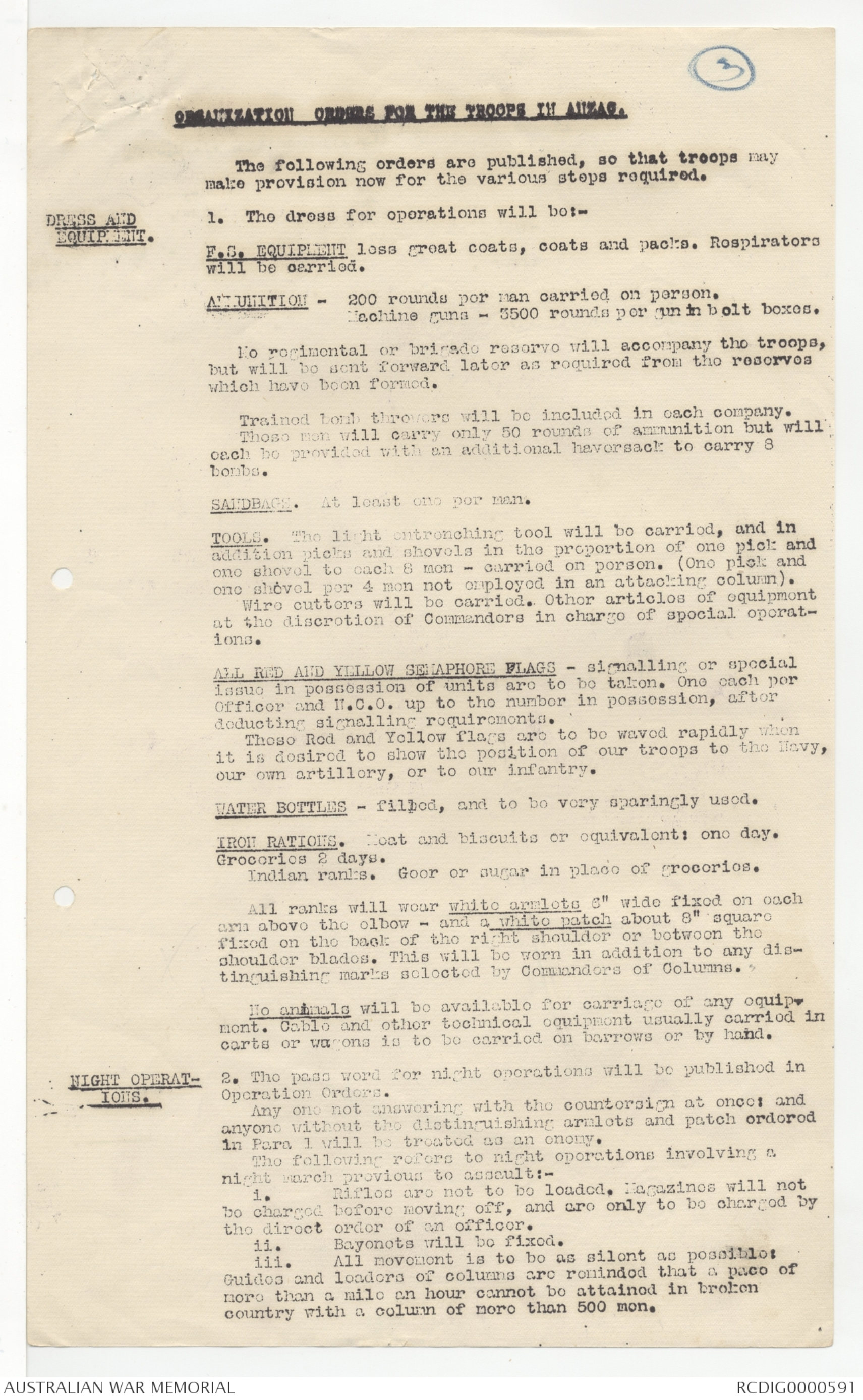
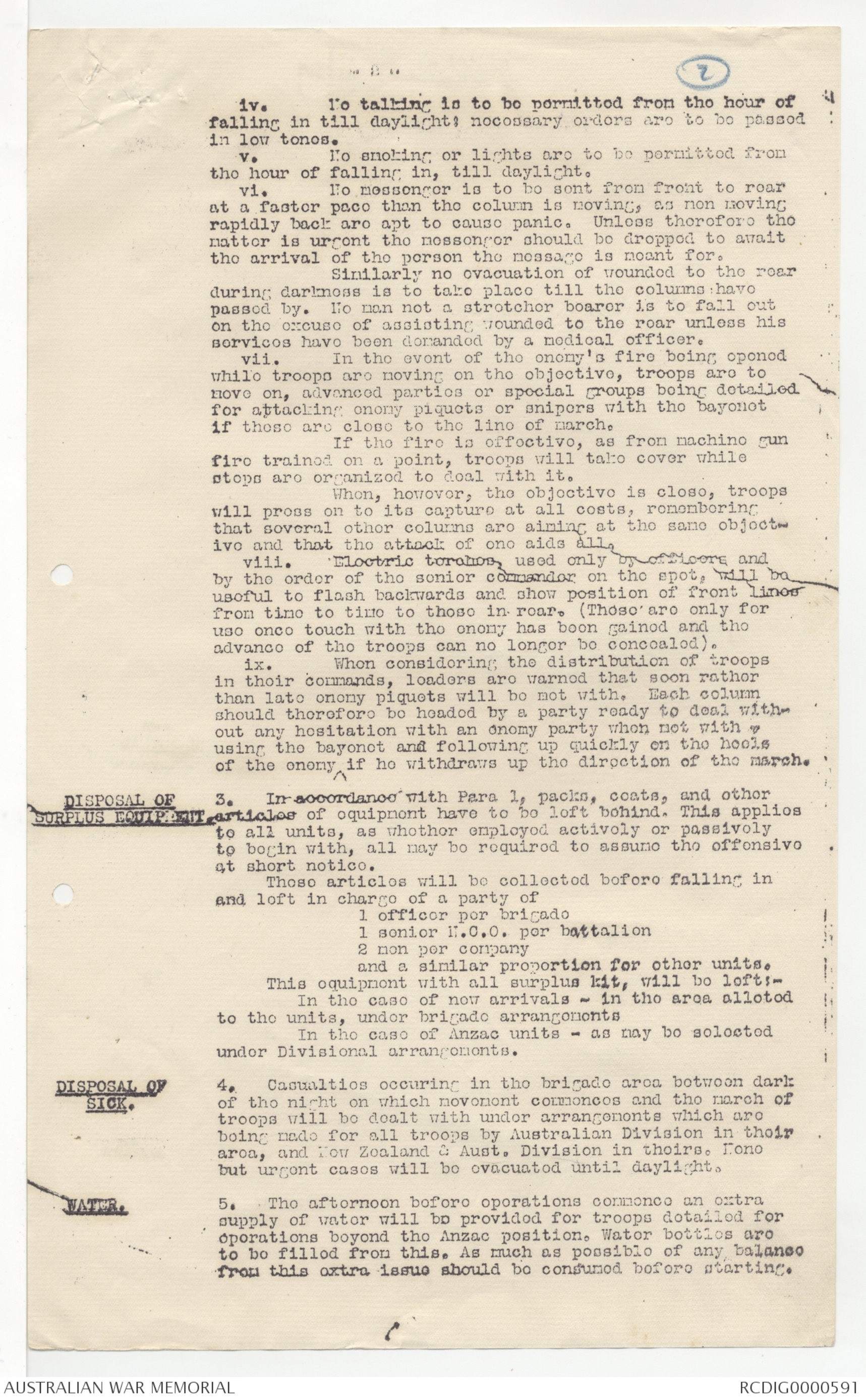
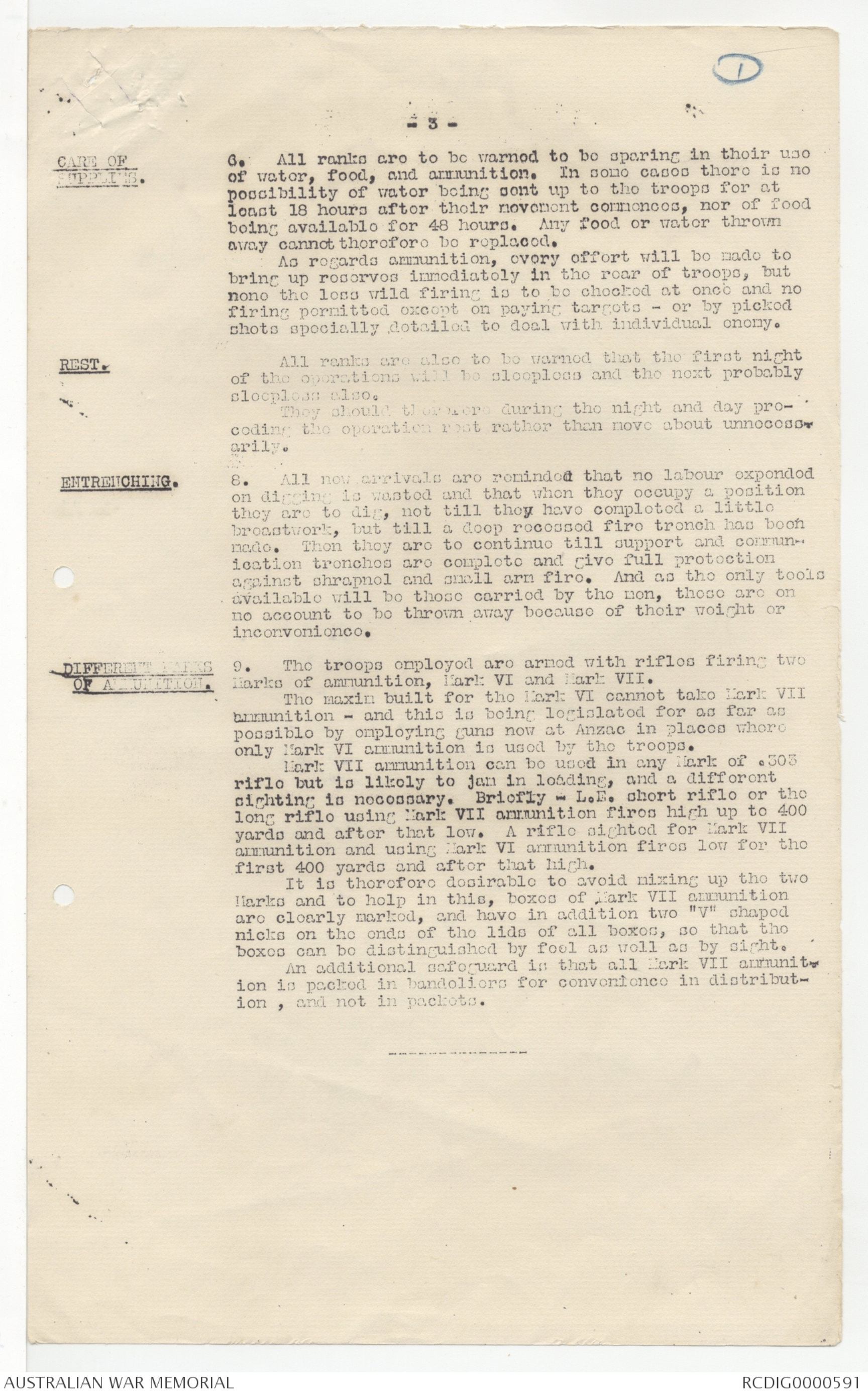
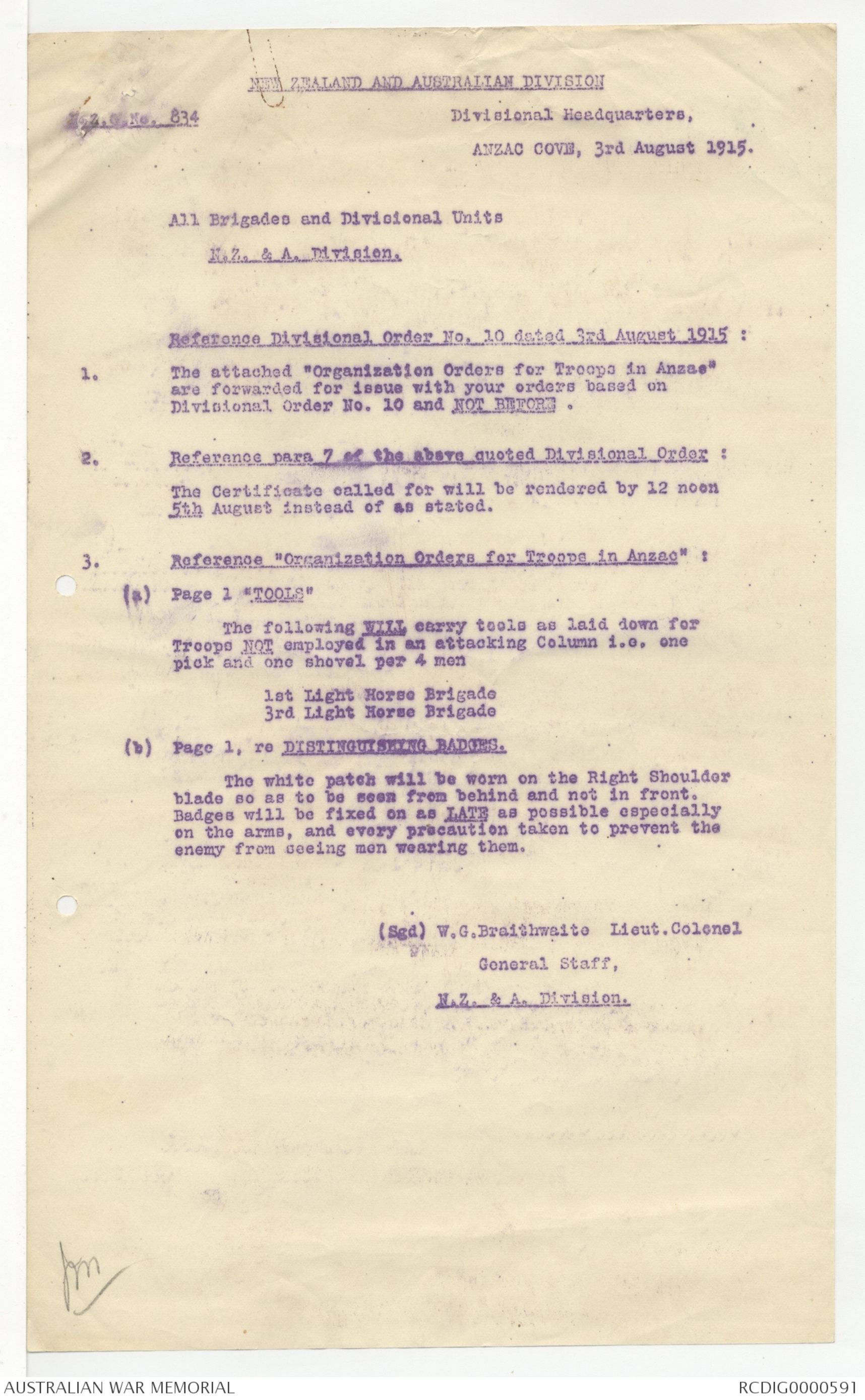
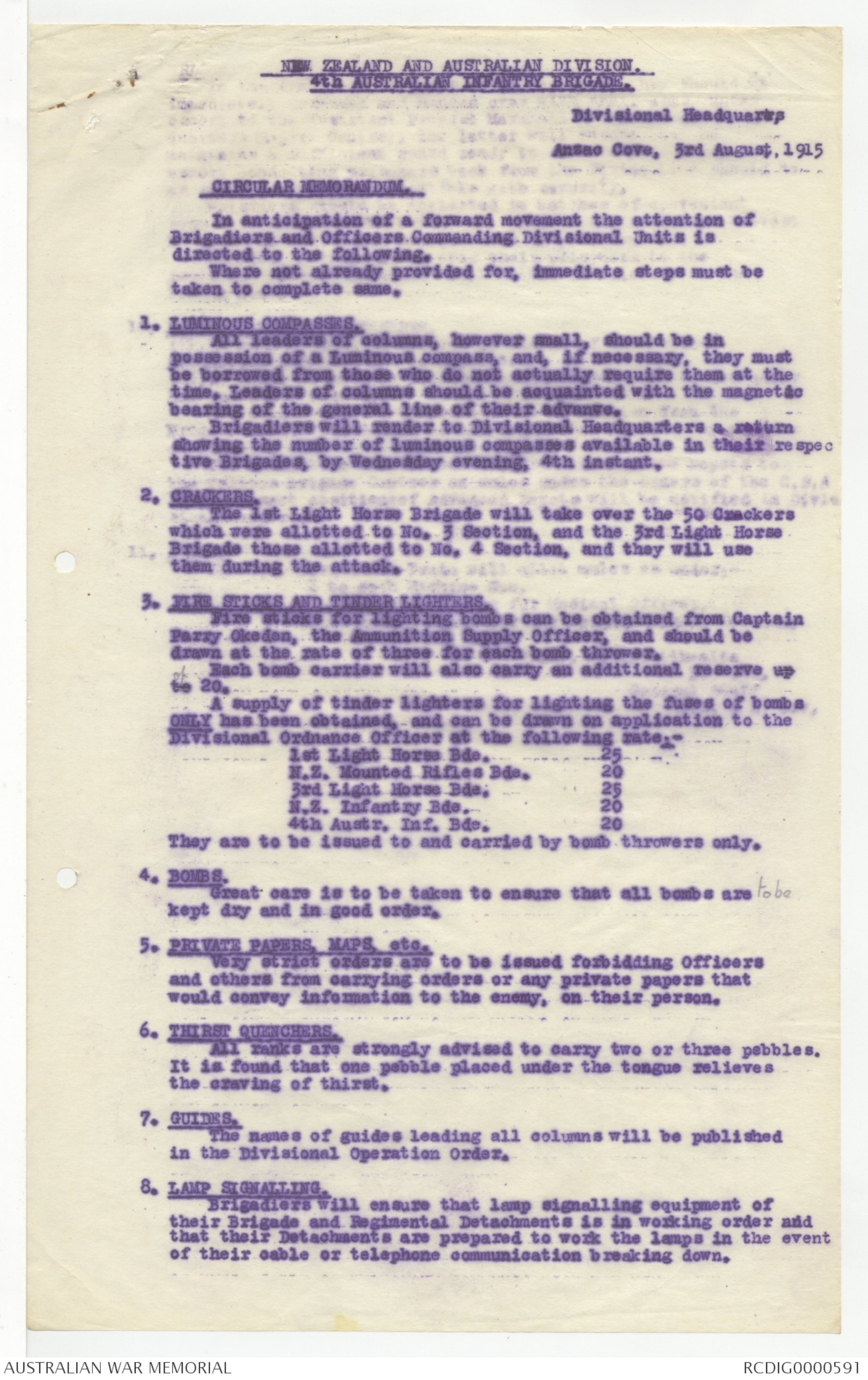
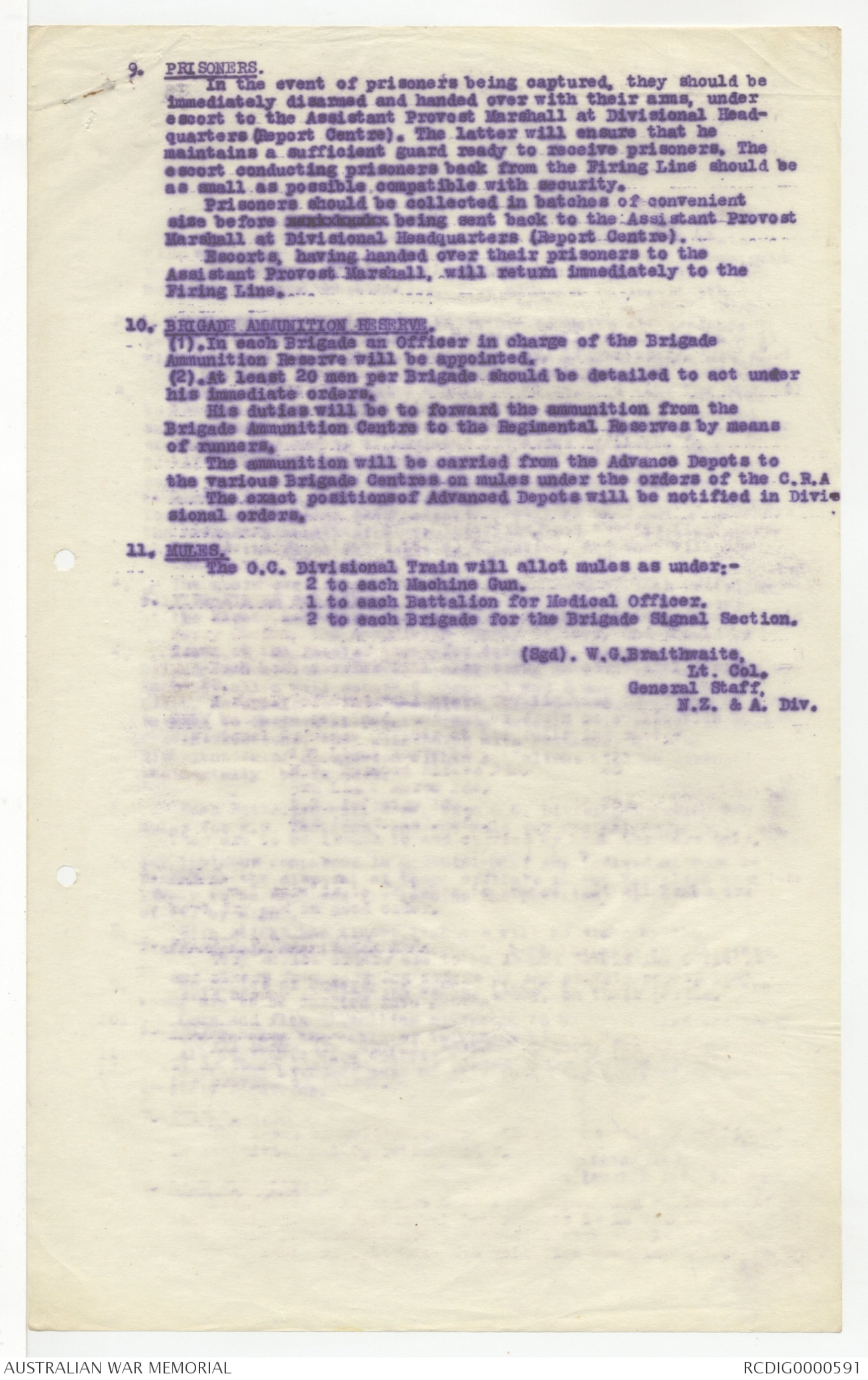
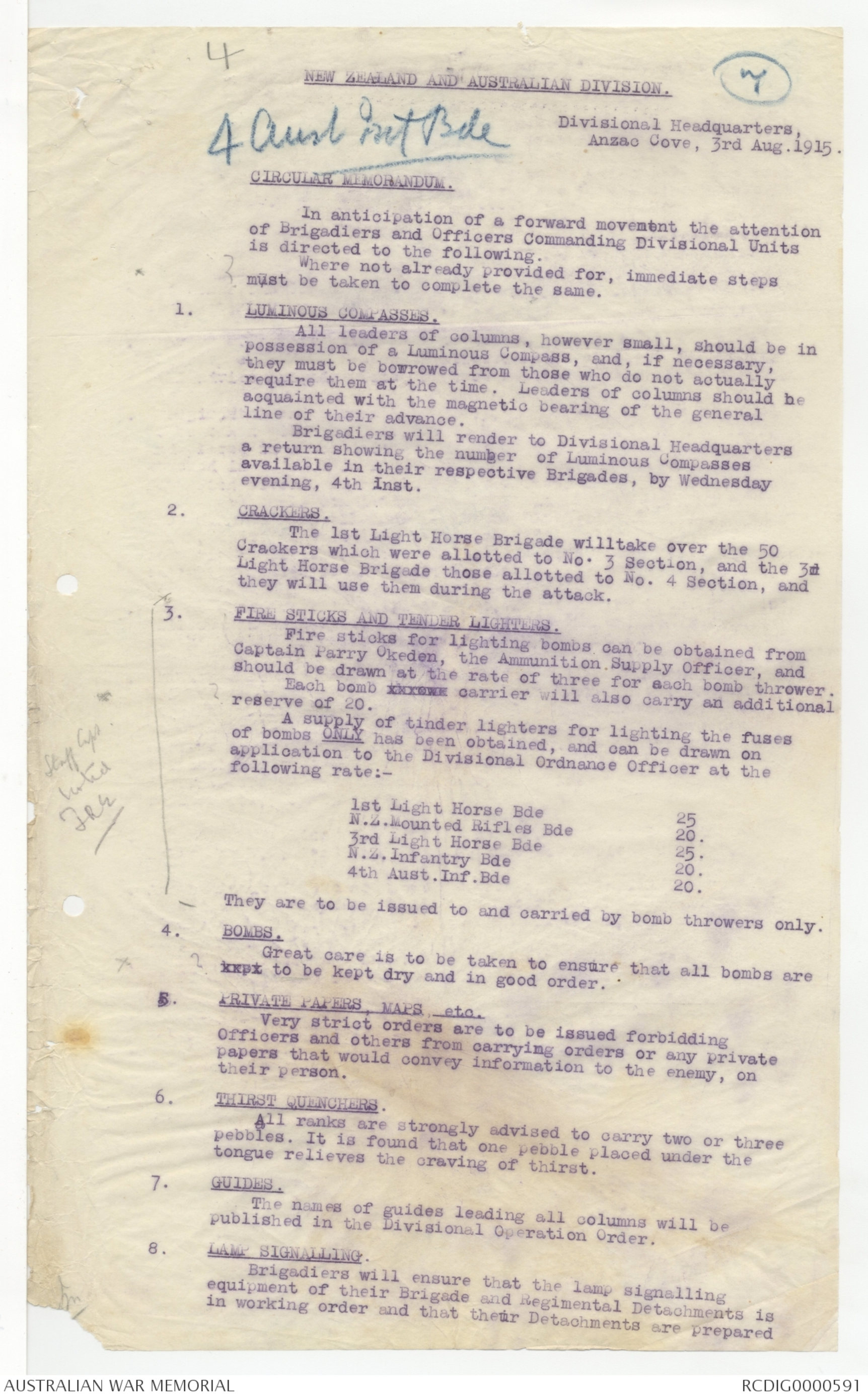
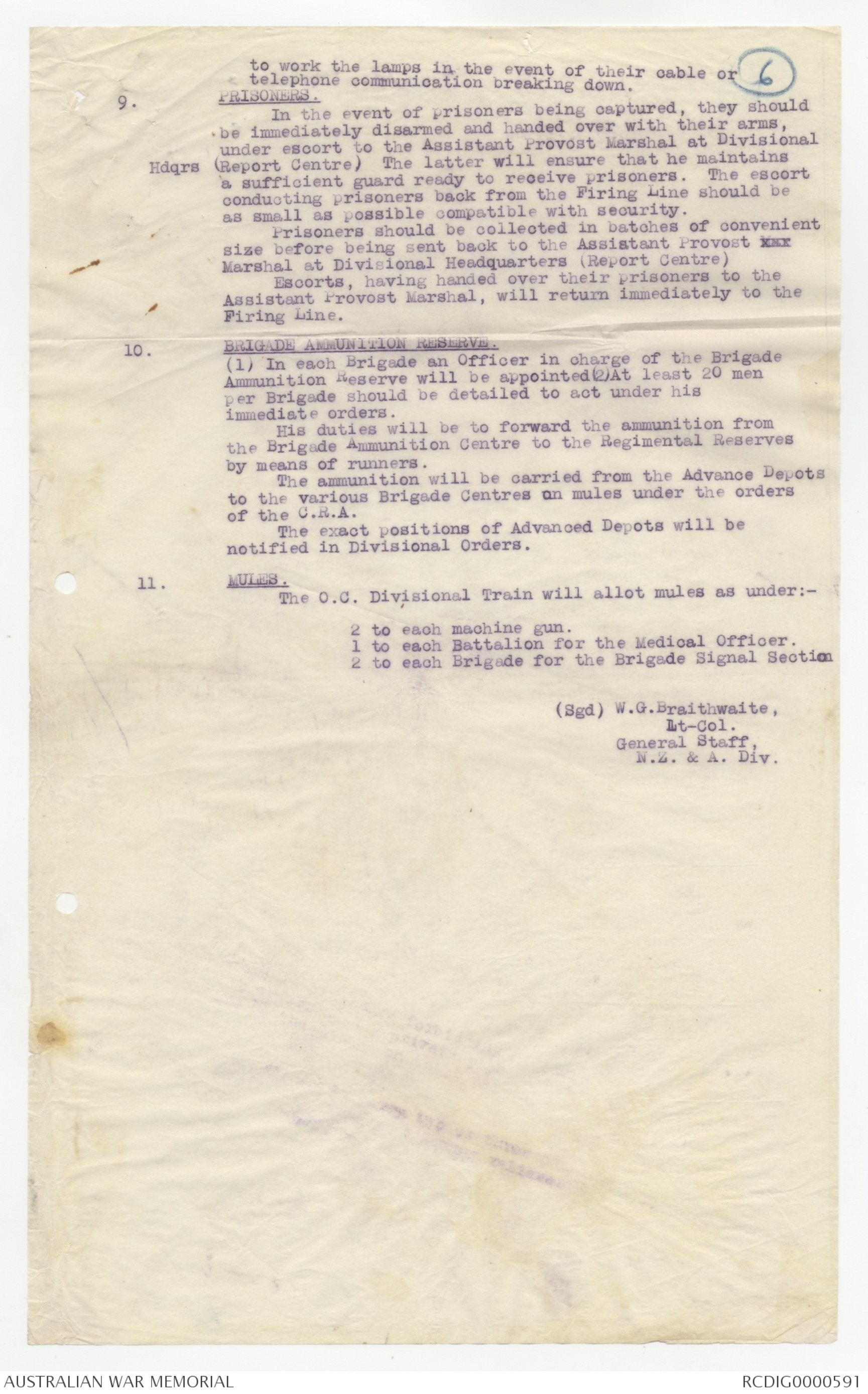
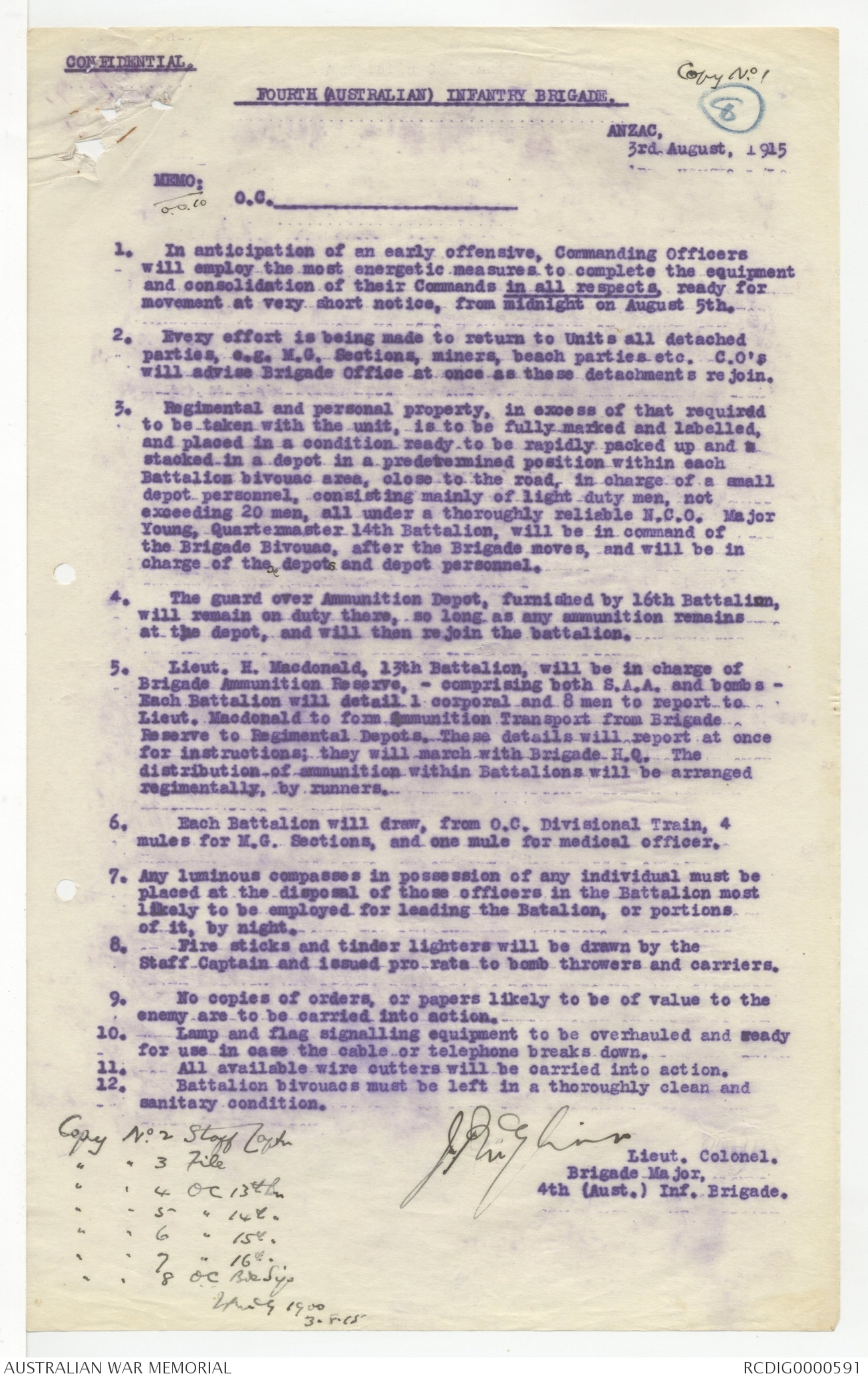
13
French Ships. Fleet Sweepers.
JM "Jauréguiberry" YXV General call sign for fleet
AJ "Charlemagne" sweepers
QV “Henri IV" BXZ General call for H.M. ships
GY “St. Louis" from fleet sweepers
YCR "Hythe"
YCS "Gazelle"
YCT "Folkestone"
Russian Ship. YCU "Newmarket"
BPR "Askold" YCV "Clacton"
YCW "Lynn"
Shore Stations. MSD "Reindeer"
Beach VWX ("Euryalus") YHC "Whitby Abbey"
Base station W1
Right flanking station W2
Left " " W3 Supply & Ammunition Ships
Beach Z ("Queen") YAI "Baron Ardrossan"
Base station W4 YAF "Carrigan Head"
Right flanking station W5 YGX "Swanley"
Left " " W6
The following additions are to be made in manuscript to the aircraft table :—
FN Fire is falling north
FS Fire is falling south
FE Fire is falling east
FW Fire is falling west
Correction to Alteration, etc , No. 1 :—
For. All signals in following tables . . . proceeded by single . . . et seq.
Read. All signals in following tables . . preceded by single . . . et seq.
Printing Section
Med. Exped. Force.
G.H.Q.
No. 3 Section
4th Aust Inf Bde
2
4.48 PM
NEW ZEALAND AND AUSTRALIAN DIVISION
4
N.Z.G.No. 834
Divisional Headquarters,
ANZAC COVE, 3rd August 1915.
All Brigades and Divisional Units
N.Z & A. Division.
Reference Divisional Order No. 10 dated 3rd August 1915 :
1. The attached "Organization Orders for Troops in Anzac"
are forwarded for issue with your orders based on
Divisional Order No. 10 and NOT BEFORE .
2. Reference para 7 of the above quoted Divisional Order :
The Certificate called for will be rendered by 12 noon
5th August instead of as stated.
3. Reference "Organization Orders for Troops in Anzac" :
(a) Page 1 "TOOLS"
The following WILL carry tools as laid down for
Troops NOT employed in an attacking Column i.e. one
pick and one shovel per 4 men.
1st Light Horse Brigade
3rd Light Horse Brigade
(b) Page 1, re DISTINGUISHING BADGES.
The white patch will be worn on the Right Shoulder
blade so as to be seen from behind and not in front.
Badges will be fixed on as LATE as possible especially
on the arms, and every precaution taken to prevent the
enemy from seeing men wearing them.
(Sgd) W. G. Braithwaite Lieut. Colonel
General staff,
N.Z. & A. Division.
3
ORGANIZATION ORDERS FOR THE TROOPS IN ANZAC.
The following orders are published, so that troops may
make provision now for the various steps required.
DRESS AND EQUIPMENT.
1. The dress for operations will be :-
F.S. EQUIPMENT less great coats, coats and packs. Respirators
will be carried.
AMMUNITION - 200 rounds per man carried on person.
Machine guns - 3500 rounds per gun in bolt boxes.
No regimental or brigade reserve will accompany the troops,
but will be sent forward later as required from the reserves
which have been formed.
Trained bomb throwers will be included in each company.
These men will carry only 50 rounds of ammunition but will
each be provided with an additional haversack to carry 8
bombs.
SANDBAGS. At least one per man.
TOOLS. The light entrenching tool will be carried, and in
addition picks and shovels in the proportion of one pick and
one shovel to each 8 men - carried on person. (One pick and
one shovel per 4 men not employed in an attacking column).
Wire cutters will be carried. Other articles of equipment
at the discretion of Commanders in charge of special operations.
ALL RED AND YELLOW SEMAPHORE FLAGS - signalling or special
issue in possession of units are to be taken. One each per
Officer and N.C.O. up to the number in possession, after
deducting signalling requirements.
Those Red and Yellow flags are to be waved rapidly when
it is desired to show the position of our troops to the Navy,
our own artillery, or to our infantry.
WATER BOTTLES - filled, and to be very sparingly used.
IRON RATIONS. Meat and biscuits or equivalent : one day.
Groceries 2 days.
Indian ranks. Goor or sugar in place of groceries.
All ranks will wear white armlets 6" wide fixed on each
arm above the elbow - and a white patch about 8" square
fixed on the back of the right shoulder or between the
shoulder blades. This will be worn in addition to any
distinguishing marks selected by Commanders of Columns.
No animals will be available for carriage of any equipment.
Cable and other technical equipment usually carried in
carts or wagons is to be carried on barrows or by hand.
NIGHT OPERATIONS.
2. The pass word for night operations will be published in
Operation Orders.
Any one not answering with the countersign at once : and
anyone without the distinguishing armlets and patch ordered
in Para 1 will be treated as an enemy.
The following refers to night operations involving a
night march previous to assault :-
i. Rifles are not to be loaded. Magazines will not
be charged before moving off, and are only to be charged by
the direct order of an officer.
ii. Bayonets will be fixed.
iii. All movement is to be as silent as possible:
Guides and leaders of columns are reminded that a pace
more than a mile an hour cannot be attained in broken
country with a column of more than 500 men.
2
"2"
iv. No talking is to be permitted from the hour of
falling in till daylight; necessary orders are to be passed
low tones.
v. No smoking or lights are to be permitted from
the hour of falling in, till daylight.
vi. No messenger is to be sent from front to rear
at a faster pace than the column is moving, as men moving
rapidly back are apt to cause panic. Unless therefore the
matter is urgent the messenger should be dropped to await
the arrival of the person the message is meant for.
Similarly no evacuation of wounded to the rear
during darkness is to take place till the columns have
passed by. No man not a stretcher bearer is to fall out
on the excuse of assisting wounded to the rear unless his
services have been demanded by a medical officer.
vii. In the event of the enemy's fire being opened
while troops are moving on the objective, troops are to
move on, advanced parties or special groups being detailed
for attacking enemy piquets or snipers with the bayonet
if those are close to the line of march.
If the fire is effective, as from machine gun
fire trained on a point, troops will take cover while
steps are organized to deal with it.
When, however, the objective is close, troops
will press on to its capture at all costs, remembering
that several other columns are aiming at the same objective
and that the attack of one aids all.
viii. Electric torches, used only by officers and
by the order of the senior commander on the spot, will be
useful to flash backwards and show position of front lines
from time to time to those in rear. (Those are only for
use once touch with the enemy has been gained and the
advance of the troops can no longer be concealed).
ix. When considering the distribution of troops
in their commands, loaders are warned that soon rather
than late enemy piquets will be met with. Each column
should therefore be headed by a party ready to deal without
any hesitation with an enemy party when met with
using the bayonet and following up quickly on the heels
of the enemy∧ if he withdraws up the direction of the march
DISPOSAL OF SURPLUS EQUIPMENT.
3. In accordance with Para, 1 pack, coats, and other
articles of equipment have to be left behind. This applies
to all units, as whether employed actively or passively
to begin with, all may be required to assume the offensive
a short notice.
These articles will be collected before falling in
and left in charge of a party of
1 officer per brigade
1 senior N.C.O. per battalion
2 men per company
and a similar proportion for other units.
This equipment with all surplus kit, will be left:–
In the case of new arrivals - in the area alloted
to the units, under brigade arrangements
In the case of Anzac units - as may be selected
under Divisional arrangements.
DISPOSAL OF SICK.
4. Casualties occuring the brigade area between dark
of the night on which movement commences and the march of
troops will be dealt with under arrangements which are
being made for all troops by Australian Division in their
area, and New Zealand & Aust. Division in theirs. None
but urgent cases will be evacuated until daylight.
WATER.
5. The afternoon before operations commence an extra
supply of water will be provided for troops detailed for
operations beyond the Anzac position. Water bottles are
to be filled from this. As much as possible of any balance
from this extra issue should be consumed before starting.
1
- 3 -
CARE OF SUPPLIES.
6. All ranks are to be warned to be sparing in their use
of water, food, and ammunition. In some cases there is no
possibility of water being sent up to the troops for at
least 18 hours after their movement commences, nor of food
being available for 48 hours. Any food or water thrown
away therefore cannot be replaced.
As regards ammunition, every effort will be made to
bring up reserves immediately in the rear of the troops, but
none the less wild firing is to be checked at once and no
firing permitted except on paying targets - or by picked
shots especially detailed to deal with individual enemy.
REST.
All ranks are also to be warned that the first night
of the operations will be sleepless and the next probably
sleepless also.
They should therefore during the night and day proceeding
the operation rest rather than move about unnecessarily.
ENTRENCHING.
8. All new arrivals are reminded that no labour expended
on digging is wasted and that when they occupy a position
they are to dig, not till they have completed a little
breastwork, but till a deep recessed fire trench has been
made. Then they are to continue till support and communication
trenches are complete and give full protection
against shrapnel and small arm fire. And as the only tools
available will be those carried by the men, these are on
no account to be thrown away because of their weight or
inconvenience.
DIFFERENT MARKS OF AMMUNITION.
9. The troops employed are armed with rifles firing two
Marks of ammunition, Mark VI and Mark VII.
The maxim built for the Mark VI cannot take Mark VII
ammunition - and this is being legislated for as far as
possible by employing guns now at Anzac in places where
only Mark VI ammunition is being used by the troops.
Mark VII ammunition can be used in any Mark of .303
rifle but is likely to jam in loading, and a different
sighting is necessary. Briefly - L.E. short rifle or the
long rifle using Mark VII ammunition fires high up to 400
yards and after that low. A rifle sighted for Mark VII
ammunition and using Mark VI ammunition fires low for the
first 400 yards and after that high.
It is therefore desirable to avoid mixing up the two
Marks and to help in this, boxes of Mark VII ammunition
are clearly marked, and have in addition two "V" shaped
nicks on the ends of the lids of all boxes, so that the
boxes can be distinguished by feel as well as by sight.
An additional safeguard is that all the Mark VII ammunition
is packed in bandoliers for convenience in distribution,
and not in packets.
-------------------------
NEW ZEALAND AND AUSTRALIAN DIVISION
Divisional Headquarters,
ANZAC COVE, 3rd August 1915.
N.Z.G.No. 834
All Brigades and Divisional Units
N.Z. & A. Division.
Reference Divisional Order No. 10 dated 3rd August 1915 :
1. The attached "organizational Orders for Troops in Anzac"
are forwarded for issue with your orders based on
Divisional Order No. 10 and NOT BEFORE .
2. Reference para 7 of the above quoted Divisional Order :
The Certificate called for will be rendered by 12 noon
5th August instead of as stated.
3. Reference "Organization Orders for troops in Anzac" :
(a) Page 1 "TOOLS"
The following WILL carry tools as laid down for
Troops NOT employed in an attacking Column i.e. one
pick and one shovel per 4 men
1st Light Horse Brigade
3rd Light Horse Brigade
(b) Page 1, re DISTINGUISHING BADGES.
The white patch will be worn on the Right Shoulder
blade so as to be seen from behind and not in front.
Badges will be fixed on as LATE as possible especially
on the arms, and every precaution taken to prevent the
enemy from seeing men wearing them.
(Sgd) W.G.Braithwaite Lieut. Colonel
General Staff,
N.Z. & A. Division
JM
NEW ZEALAND AND AUSTRALIAN DIVISION.
4th AUSTRALIAN INFANTRY DIVISION.
Divisional Headquartrs
Anzac Cove, 3rd August, 1915
CIRCULAR MEMORANDUM.
In anticipation of a forward movement the attention of
Brigadiers and Officers Commanding Divisional Units is
directed to the following.
Where not already provided for, immediate steps must be
taken to complete same.
1. LUMINOUS COMPASSES.
All leaders of columns, however small, should be in
possession of a Luminous compass, and, if necessary, they must
be borrowed from those who do not actually require them at the
time. Leaders of columns should be acquainted with the magnetic
bearing of the general line of their advance.
Brigadiers will render to the Divisional Headquarters a return
showing the number of luminous compasses available in their respective
Brigades, by Wednesday evening, 4th instant.
2. CRACKERS.
The 1st Light Horse Brigade will take over the 50 Crackers
which were allotted to No. 3 Section, and the 3rd Light Horse
Brigade those allotted to the No.4 Section, and they will use
them during the attack.
3. FIRE STICKS AND TINDER LIGHTERS.
Fire sticks for lighting bombs can be obtained from Captain
Parry Okeden, the Ammunition Supply Officer, and should be
drawn at the rate of three for each bomb thrower.
Each bomb carrier will also carry an additional reserve up
to 20.
A supply of tinder lighters for lighting the fuses of bombs
ONLY has been obtained, and can be drawn on application to the
Divisional Ordnance Officer at the following rate:-
1st Light Horse Bde. 25
N.Z. Mounted Rifles Bde. 20
3rd Light Horse Bde. 25
N.Z. Infantry Bde. 20
4th Austr. Inf. Bde. 20
They are to be issued to and carried by bomb throwers only.
4. BOMBS.
Great care is to be taken to ensure that all bombs are
to be kept dry and in good order.
5. PRIVATE PAPERS, MAPS, ETC.
Very strict orders are to be issued forbidding Officers
and others from carrying orders or any private papers that
would convey information to the enemy, on their person.
6. THIRST QUENCHERS.
All ranks are strongly advised to carry two or three pebbles.
It is found that one pebble placed under the tongue relieves
the craving of thirst.
7. GUIDES.
The names of guides leading all columns will be published
in the Divisional Operation Order.
8. LAMP SIGNALLING.
Brigadiers will ensure that lamp signalling equipment of
their Brigade and Regimental Detachments is in working order and
that their Detachments are prepared to work the lamps in the event
of their cable or telephone communication breaking down.
9. PRISONERS.
In the event of prisoners being captured, they should be
immediately disarmed and handed over with their arms, under
escort to the Assistant Provost Marshall at Divisional Headquarters
(Report Centre). The latter will ensure that he
maintains a sufficient guard ready to receive prisoners. The
escort conducting prisoners back from the Firing Line should be
as small as possible compatible with security.
Prisoners should be collected in batches of convenient
size before sent back being sent back to the Assistant Provost
Marshall at Divisional Headquarters (Report Centre).
Escorts, having handed over their prisoners to the
Assistant Provost Marshall, will return immediately to the
Firing Line.
10. BRIGADE AMMUNITION RESERVE.
(1).In each Brigade an Officer in charge of the Brigade
Ammunition reserve will be appointed.
(2).At least 20 men per brigade should be detailed to act under
his immediate orders.
His duties will be to forward the ammunition from the
Brigade Ammunition Centre to the Regimental Reserves by means
of runners.
The ammunition will be carried from the Advance Depots to
the various Brigade Centres on mules under the orders of the C.R.A
The exact positionsof Advanced Depots will be notified in Divisional
orders.
11. MULES.
The O.C. Divisional train will allot mules as under:-
2 to each Machine Gun.
1 to each Battalion for Medical Officer.
2 to each Brigade for the Brigade Signal Section.
(Sgd). W.G. Braithwaite,
Lt. Col.
General Staff,
N.Z. & A. Div.
4
7
NEW ZEALAND AND AUSTRALIAN DIVISION.
Divisional Headquarters
Anzac Cove, 3rd August.1915.
4 Aust Inf Bde
CIRCULAR MEMORANDUM
In anticipation of a forward movement the attention
of Brigadiers and Officers Commanding Divisional Units
is directed to the following.
Where not already provided for, immediate steps
[*?*] must be taken to complete the same.
1. LUMINOUS COMPASSES.
All leaders of columns, however small, should be in
possession of a Luminous Compass, and, if necessary,
they must be borrowed from those who do not actually
require them at the time. Leaders of columns should be
acquainted with the magnetic bearing of the general
line of their advance.
Brigadiers will render to the Divisional Headquarters
a return showing the numgber of Luminous Compasses
available in their respective Brigades, by Wednesday
evening, 4th inst.
2. CRACKERS.
The 1st Light Horse Brigade willtake over the 50
Crackers which were allotted to No. 3 Section, and the 3rd
Light Horse Brigade those allotted to No. 4 Section, and
they will use them during the attack.
3. FIRE STICKS AND TINDER LIGHTERS.
Fire sticks for lighting bombs can be obtained from
Captain Parry Okeden, the Ammunition Supply Officer, and
should be drawn at the rate of three for each bomb thrower.
Each bomb thrower carrier will also carry an additional
reserve of 20.
[*Staff Capt
noted
FRE*]
A supply of tinder lighters for lighting the fuses
of bombs ONLY has been obtained, and can be drawn
on application to the Divisional Ordnance Officer at the
following rate:-
1st Light Horse Bde. 25
N.Z. Mounted Rifles Bde. 20.
3rd Light Horse Bde. 25.
N.Z. Infantry Bde. 20.
4th Aust. Inf. Bde. 20.
They are to be issued to and carried by bomb throwers only.
4. BOMBS.
Great care is to be taken to ensure that all bombs are
[*x?*] kept to be kept dry and in good order.
5. PRIVATE PAPERS, MAPS, etc.
Very strict orders are to be issued forbidding
Officers and others from carrying orders or any private
papers that would convey information to the enemy, on
their person.
6. THIRST QUENCHERS.
All ranks are strongly advised to carry two or three
pebbles. It is found that one pebble placed under the
tongue relieves the craving of thirst.
7. GUIDES.
The names of guides leading all columns will be
published in the Divisional Operation Order.
8. LAMP SIGNALLING.
Brigadiers will ensure that lamp signalling
equipment of their Brigade and Regimental Detachments is
in working order and that theuir Detachments are prepared
6.
to work the lamps in the event of their cable or
telephone communication breaking down.
9. PRISONERS.
In the event of prisoners being captured, they should
be immediately disarmed and handed over with their arms,
under escort to the Assistant Provost Marshal at Divisional
Hdqrs (Report Centre). The latter will ensure that he maintains
a sufficient guard ready to receive prisoners. The escort
conducting prisoners back from the Firing Line should be
as small as possible compatible with security.
Prisoners should be delivered in batches of convenient
size before being sent back to the Assistant Provost xxx
Marshal at Divisional Headquarters (Report Centre).
Escorts, having handed over their prisoners to the
Assistant Provost Marshal, will return immediately to the
Firing Line.
10. BRIGADE AMMUNITION RESERVE.
(1) In each Brigade an Officer in charge of the Brigade
Ammunition reserve will be appointed(2)At least 20 men
per brigade should be detailed to act under his
immediate orders.
His duties will be to forward the ammunition from
the Brigade Ammunition Centre to the Regimental Reserves
by means of runners.
The ammunition will be carried from the Advance Depots
to the various Brigade Centres on mules under the orders
of the C.R.A.
The exact positions of Advanced Depots will be
notified in Divisional orders.
11. MULES.
The O.C. Divisional Train will allot mules as under:-
2 to each machine gun.
1 to each Battalion for Medical Officer.
2 to each Brigade for the Brigade Signal Section
(Sgd). W.G. Braithwaite,
Lt-Col.
General Staff,
N.Z. & A. Div.
CONFIDENTIAL.
[*Copy No 1*]
FOURTH (AUSTRALIAN) INFANTRY BRIGADE.
8
ANZAC,
3rd August, 1915
MEMO:
O.O.CO
O.C. _____________________
1. In anticipation of an early offensive, Commanding Officers
will employ the most energetic measures to complete the equipment
and consolidation of their Commands in all respects, ready for
movement at very short notice, from midnight on August 5th.
2. Every effort is being made to return to Units all detached
parties, e.g. M.G. Sections, miners, beach parties etc. C.O's
will advise Brigade Office at once as these detachment s re join.
3. Regimental and personal property, in excess of that required
to be taken with the unit, is to be fully marked and labelled,
and placed in a condition ready to be rapidly packed up and a
stacked in a depot in a predetermined position within each
Battalion bivouac area, close to the road, in charge of a small
depot personnel, consisting mainly of light duty men, not
exceeding 20 men, all under a thoroughly reliable N.C.O. Major
Young, Quartermaster 14th Battalion, will be in command of
the Brigade Bivouac, after the Brigade moves, and will be in
charge of these depots and depot personnel.
4. The guard over Ammunition Depot, furnished by 16th Battalion,
will remain on duty there, so long as any ammunition remains
at the depot, and will then rejoin the battalion.
5. Lieut. H. Macdonald, 13th Battalion, will be in charge of
Brigade Ammunition Reserve, - comprising both S.A.A. and bombs -
Each Battalion will detail 1 corporal and 8 men to report to
Lieut. Macdonald to form Ammunition Transport from Brigade
Reserve to Regimental Depots. These details will report at once
for instructions; they will march with Brigade H.Q. The
distribution of ammunition within Battalions will be arranged
regimentally, by runners.
6. Each Battalion will draw, from O.C. Divisional Train, 4
mules for M.G. Sections, and one mule for medical officer.
7. Any luminous compasses in possession of any individual must be
placed at the disposal of those officers in the Battalion most
likely to be employed for leading the Battalion, or portions
it, by night.
8. Fire sticks and tinder lighters will be drawn by the
Staff Captain and issued pro rata to bomb throwers and carriers.
9. No copies of orders, or papers likely to be of value to the
enemy are to be carried into action.
10. Lamp and flag signalling equipment to be overhauled and ready
for use in case the cable or telephone breaks down.
11. All available wire cutters will be carried into action.
12. Battalion bivouacs must be left in a thoroughly clean and
sanitary condition.
JP McGlinn
Lieut. Colonel.
Brigade Major.
4th (Aust.) Inf. Brigade.
Copy No 2 Staff Capt
" " 3 File
" " 4 OC 13th Bn
" " 5 " 14th.
" " 6 " 15th.
" " 7 " 16th.
" " 8 O.C. Bde Sigs
JPMcG 1900
3.8.15
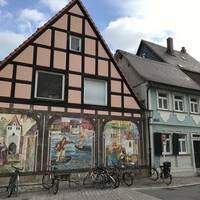 Robyn G
Robyn GThis transcription item is now locked to you for editing. To release the lock either Save your changes or Cancel.
This lock will be automatically released after 60 minutes of inactivity.